Handsworth, Birmingham Worksheets
Do you want to save dozens of hours in time? Get your evenings and weekends back? Be able to teach about Handsworth, Birmingham to your students?
Our worksheet bundle includes a fact file and printable worksheets and student activities. Perfect for both the classroom and homeschooling!
Resource Examples
Click any of the example images below to view a larger version.
Fact File
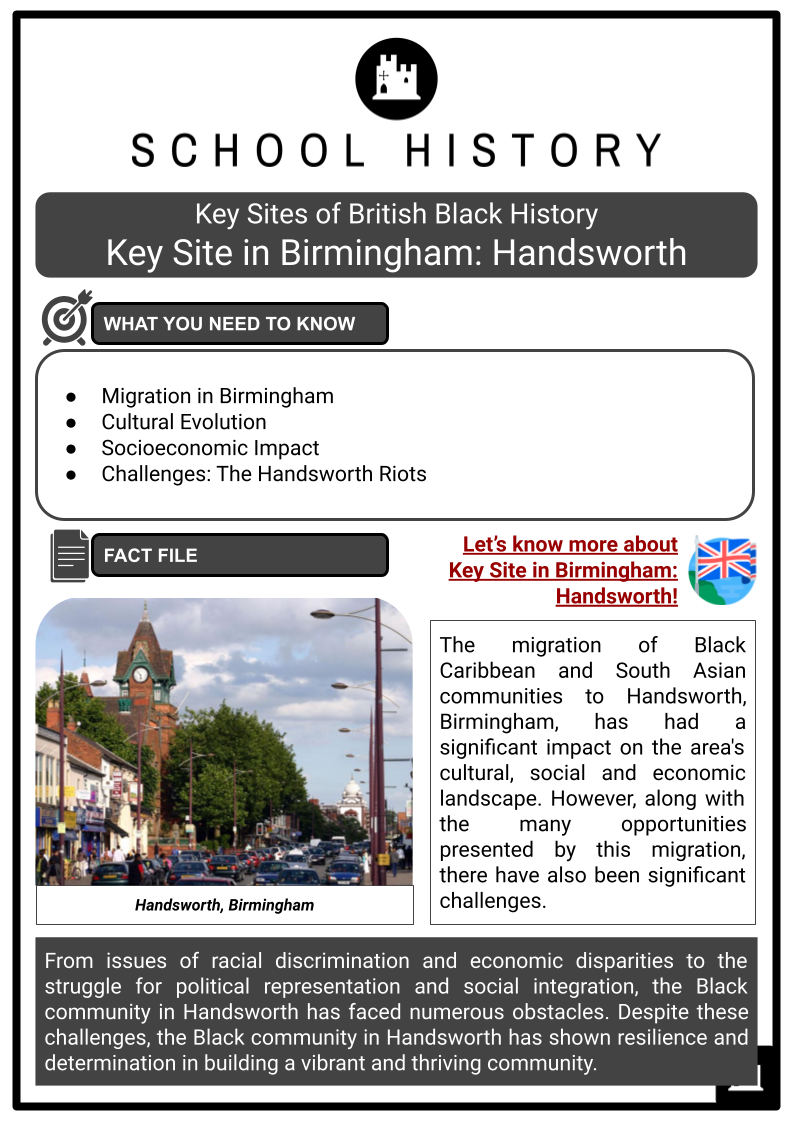
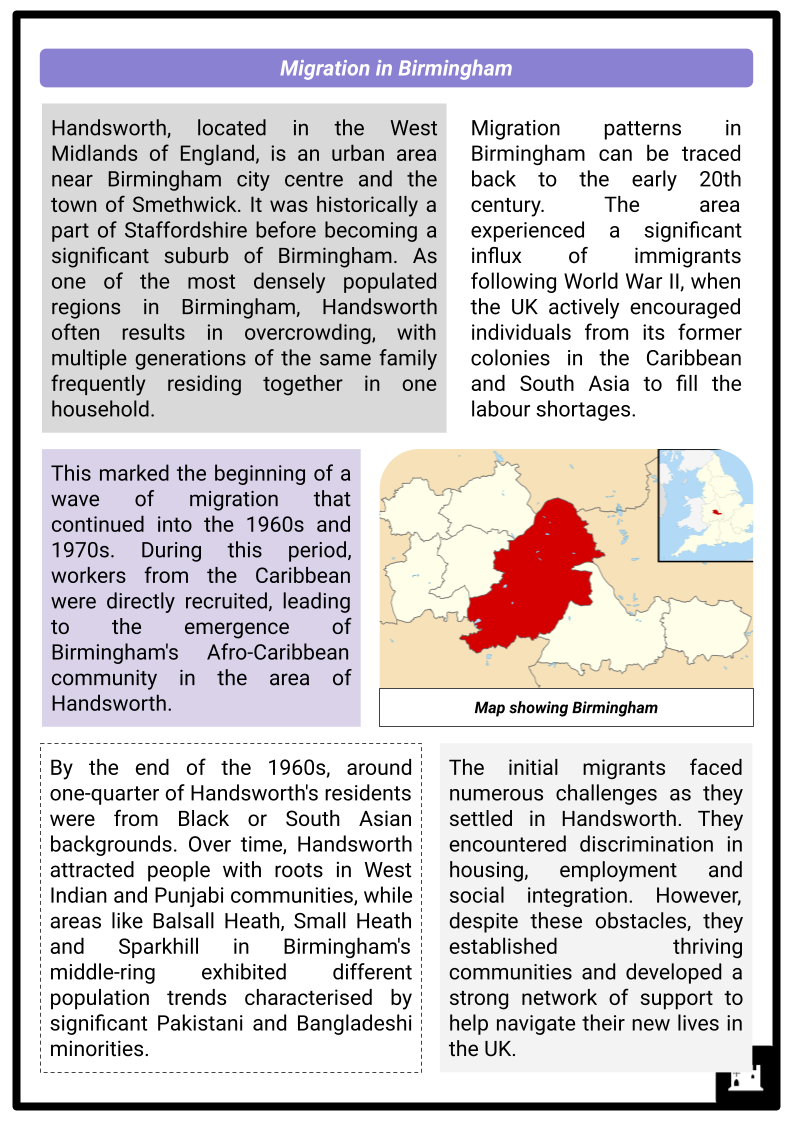
Student Activities
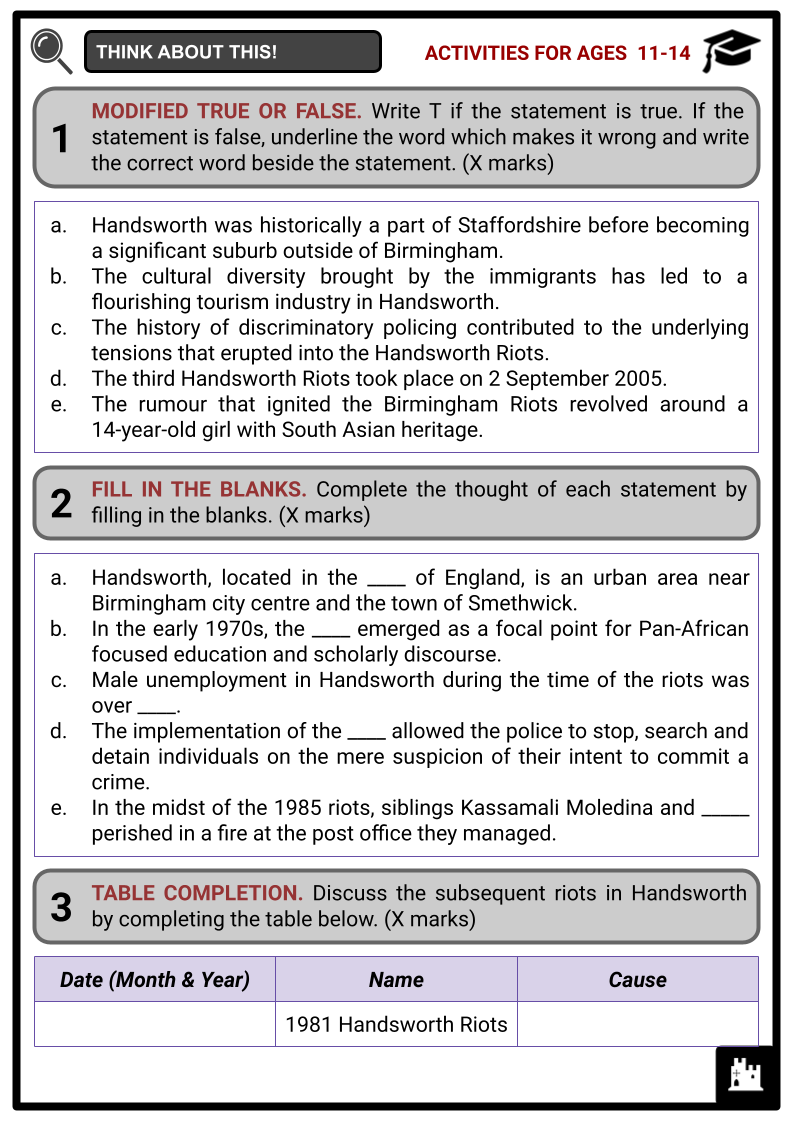
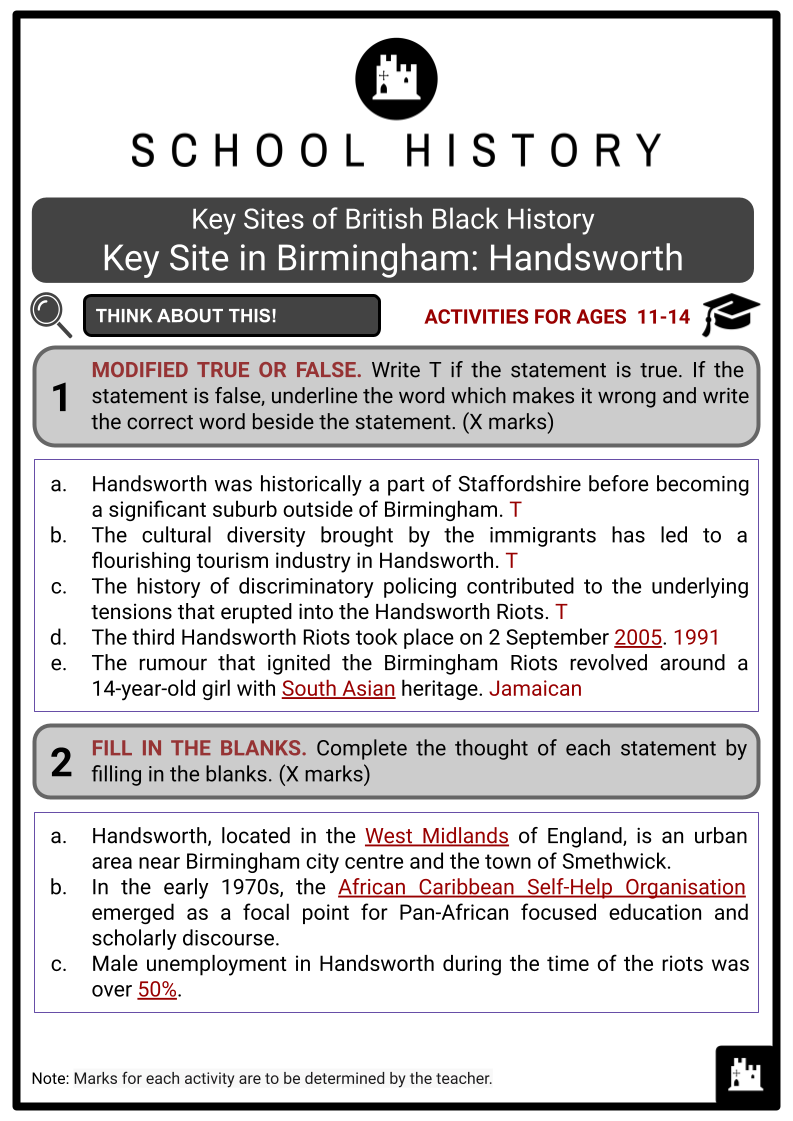
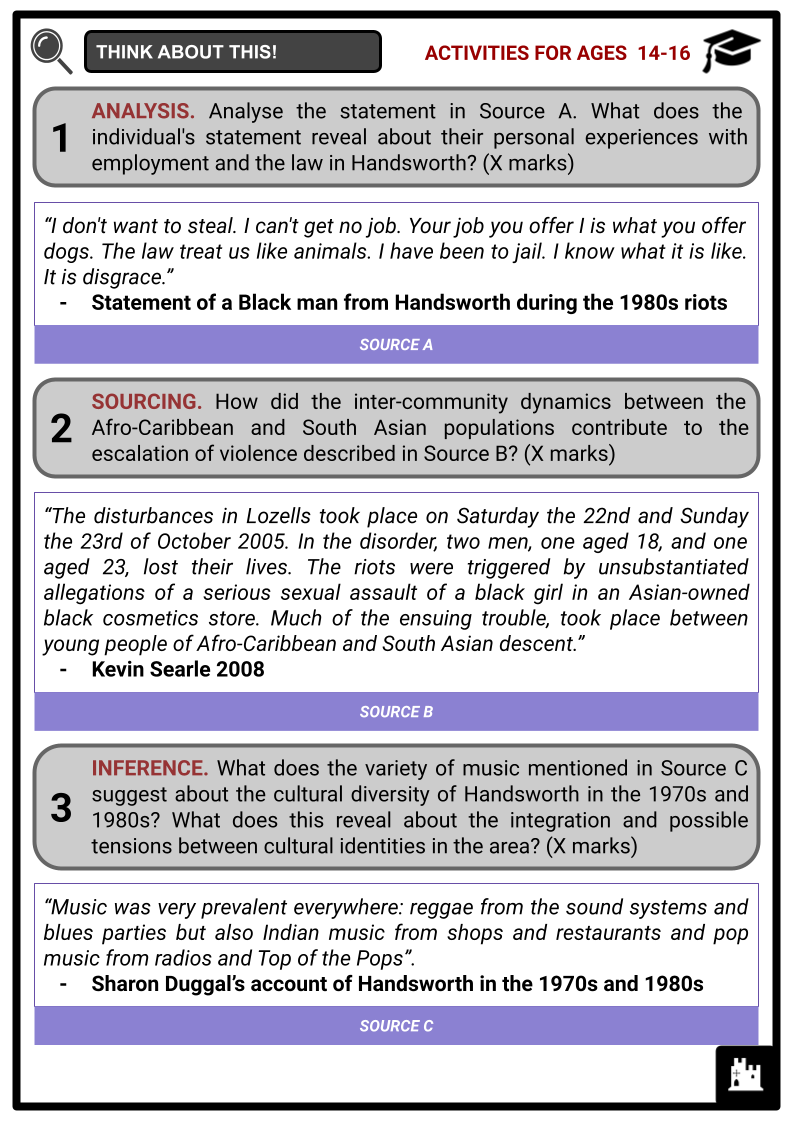
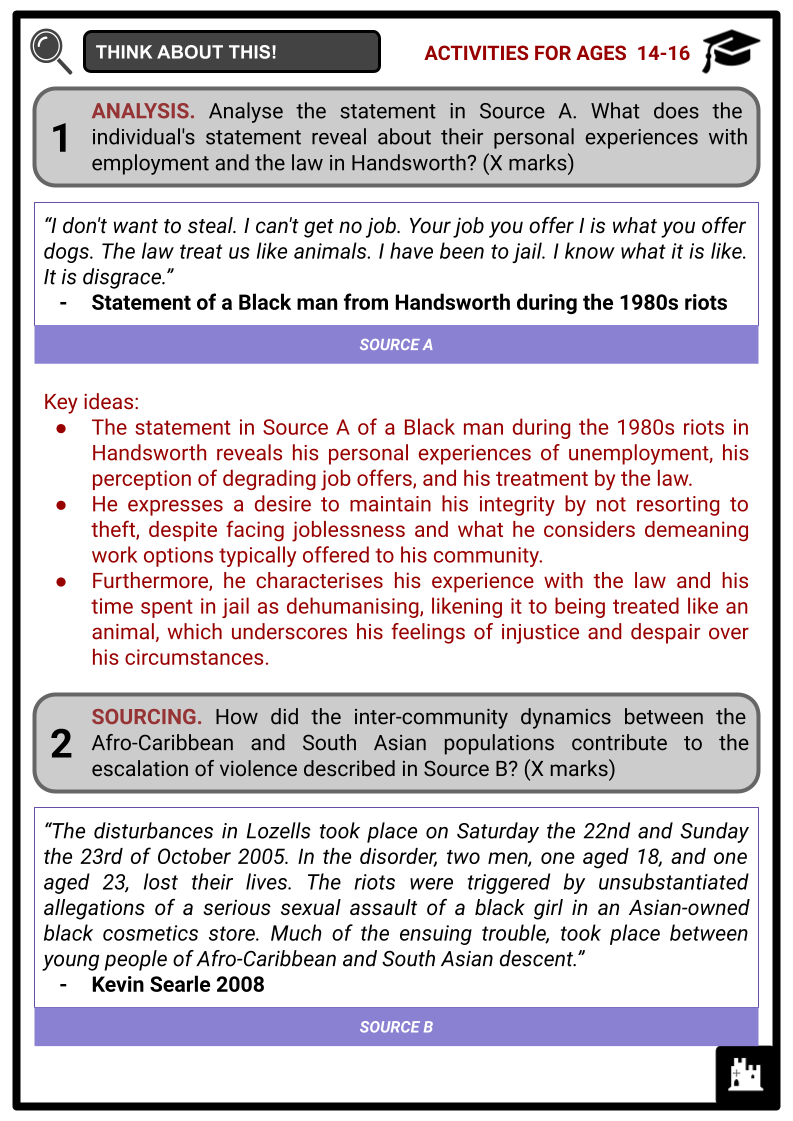
Summary
- Migration in Birmingham
- Cultural Evolution
- Socioeconomic Impact
- Challenges: The Handsworth Riots
Key Facts And Information
Let’s know more about Key Site in Birmingham: Handsworth!
The migration of Black Caribbean and South Asian communities to Handsworth, Birmingham, has had a significant impact on the area's cultural, social and economic landscape. However, along with the many opportunities presented by this migration, there have also been significant challenges.
From issues of racial discrimination and economic disparities to the struggle for political representation and social integration, the Black community in Handsworth has faced numerous obstacles. Despite these challenges, the Black community in Handsworth has shown resilience and determination in building a vibrant and thriving community.
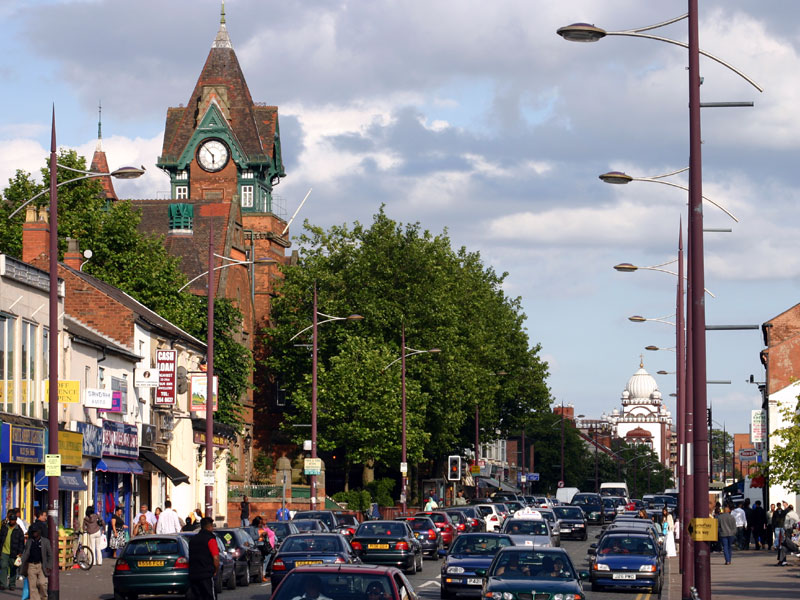
Migration in Birmingham
- Handsworth, located in the West Midlands of England, is an urban area near Birmingham city centre and the town of Smethwick. It was historically a part of Staffordshire before becoming a significant suburb of Birmingham. As one of the most densely populated regions in Birmingham, Handsworth often results in overcrowding, with multiple generations of the same family frequently residing together in one household.
- Migration patterns in Birmingham can be traced back to the early 20th century. The area experienced a significant influx of immigrants following World War II, when the UK actively encouraged individuals from its former colonies in the Caribbean and South Asia to fill the labour shortages.
- This marked the beginning of a wave of migration that continued into the 1960s and 1970s. During this period, workers from the Caribbean were directly recruited, leading to the emergence of Birmingham's Afro-Caribbean community in the area of Handsworth.
- By the end of the 1960s, around one-quarter of Handsworth's residents were from Black or South Asian backgrounds. Over time, Handsworth attracted people with roots in West Indian and Punjabi communities, while areas like Balsall Heath, Small Heath and Sparkhill in Birmingham's middle-ring exhibited different population trends characterised by significant Pakistani and Bangladeshi minorities.
- The initial migrants faced numerous challenges as they settled in Handsworth. They encountered discrimination in housing, employment and social integration. However, despite these obstacles, they established thriving communities and developed a strong network of support to help navigate their new lives in the UK.
- Over time, these communities became integral to the social and cultural fabric of Handsworth. They brought with them their traditions, languages, music and cuisine, all of which greatly enriched the local culture. The establishment of businesses and community organisations contributed to the economic and social development of the area.
- Moreover, the activism and advocacy that arose from the challenges of migration have left a lasting impact on Handsworth. The community organised to demand equal rights, fight against racism and promote social inclusion, leading to changes in policies and attitudes that benefited not only the migrants but also the broader community.
Cultural Evolution
- The cultural evolution in Handsworth is a testament to the resilience, creativity and adaptability of its diverse immigrant communities. The infusion of traditions, languages, music and cuisine from the Caribbean and South Asia has woven a rich tapestry of cultural expression in this area.
- One of the most striking aspects of this cultural evolution is the transformation of Handsworth into a vibrant multicultural hub. The fusion of different cultural elements has given rise to unique festivals, events and artistic expressions that celebrate the diversity of the community. This blending of traditions has not only preserved the heritage of the immigrants but also created a dynamic and inclusive environment for all residents.
- The impact of this cultural evolution extends beyond the social realm. The entrepreneurial spirit of the immigrant communities has contributed to the growth of small businesses, particularly in the food and retail sectors. These businesses have not only provided economic opportunities for the residents but have also become focal points for cultural exchange and community interaction.
- Furthermore, the cultural evolution in Handsworth has sparked a renaissance in the arts and music scene. The vibrant sounds of reggae, calypso and bhangra resonate through the streets, reflecting the unique fusion of musical styles and traditions. This has not only enriched the local cultural landscape but has also garnered national and international recognition, putting Handsworth on the map as a cultural hotspot.
- The evolution of Handsworth's culture is a testament to the enduring legacy of its immigrant communities. Their resilience, contributions and rich cultural heritage have shaped Handsworth into a model of multicultural coexistence and set a precedent for other communities to emulate.
Socioeconomic Impact
- The socioeconomic impact of the immigrant communities in Handsworth has been profound and far-reaching. The influx of immigrants from the Caribbean and South Asia has greatly influenced the economic and social landscape of the area.
- Firstly, the establishment of small businesses by the immigrant communities has significantly contributed to the local economy. These enterprises, ranging from grocery stores and restaurants to clothing and speciality shops, have not only provided essential goods and services to the residents but also created employment opportunities and stimulated economic growth within the community.
- Additionally, the cultural diversity brought by the immigrants has led to a flourishing tourism industry in Handsworth. The unique festivals, events and culinary experiences have attracted tourists and visitors, thereby bolstering the local economy through increased spending in the hospitality and entertainment sectors.
- Furthermore, the resilience and determination of the immigrants in overcoming the initial challenges of discrimination and marginalisation have paved the way for social integration and cohesion in Handsworth. The community's advocacy for equal rights and social inclusion has fostered a more equitable society, where individuals from diverse backgrounds can actively participate in the social, cultural and economic life of the area.
- One such organisation that has played a pivotal role in the development and empowerment of the Black communities in Handsworth is the African Caribbean Self-Help Organisation (ACSHO), based at Heathfield Road. In the early 1970s, it emerged as a focal point for Pan-African focused education and scholarly discourse. Since its formation, ACSHO has been instrumental in addressing the specific needs and challenges faced by the Black community, such as educational support, employment opportunities and social welfare.
- The cultural exchange facilitated by the immigrant communities has not only enriched the local cultural scene but also created opportunities for collaboration and partnership with mainstream institutions and organisations. This collaboration has led to initiatives that promote diversity and inclusion, ultimately benefiting the entire community.
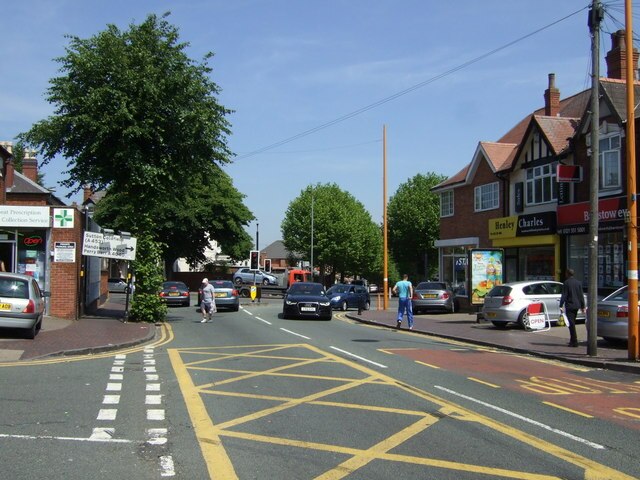
Challenges: The Handsworth Riots
- The immigrant communities in Handsworth have faced a myriad of challenges as they navigated their way through a new and unfamiliar environment. One of the most significant obstacles was the discrimination and prejudice they encountered in various aspects of their lives. From housing and employment to social interactions, the immigrants often had to confront systemic biases and stereotypes that hindered their integration into the broader society.
- Moreover, the language barrier proved to be a formidable challenge for many immigrants, particularly the elderly and those with limited educational opportunities. Communicating effectively and accessing essential services in a new country with a different language posed significant difficulties and created feelings of isolation and alienation.
- In addition, the immigrants grappled with the loss of their familiar support systems and social structures. The move to a new country meant leaving behind their networks of relatives, friends and community connections, which often led to feelings of loneliness and disconnection.

- The challenges faced by the immigrant communities in Handsworth were also exacerbated by the strained relationship with the local police, ultimately culminating in the 1981 Handsworth Riots. The history of discriminatory policing and the socioeconomic struggles of the residents due to the high unemployment rate (male unemployment in Handsworth was over 50%) contributed to the underlying tensions that erupted into violence and unrest that involved disadvantaged Black, Asian and white youths.
- The relationship between the police and the immigrant communities in Handsworth was marred by distrust, mistreatment and a lack of cultural sensitivity. Residents often felt unfairly targeted and policed, leading to a breakdown in trust and cooperation. Instances of police brutality and discriminatory practices further fuelled the growing resentment towards law enforcement.
- Before the riots, Handsworth was seen as a model of effective community policing. However, young Black British locals contested this portrayal by stating that relations with the police were not as friendly as claimed, citing that about 40% of them had been subjected to stop and search in the preceding year due to the Vagrancy Act 1824 or 'sus' law.
- The sus law was a contentious issue that deeply affected the relationship between the immigrant communities and the local police in Handsworth. The implementation of this law allowed the police to stop, search and detain individuals on the mere suspicion of their intent to commit a crime.
- This vague and discretionary power often resulted in the arbitrary targeting of minority communities, leading to feelings of injustice and alienation.
- The sus law disproportionately impacted the immigrant communities, particularly young Black British individuals, who were profiled and subjected to frequent stops and searches. This discriminatory practice not only heightened tensions between the police and the community but also perpetuated a climate of fear and resentment.
- On the evening of Friday 10 July and over the next two nights, a significant increase in violent incidents occurred. The riots were described in the Scarman report on the 1981 England riots as 'copycat riots' following the Brixton riots in London, and happening concurrently with the Toxteth riots in Liverpool and the Moss Side riots in Manchester.
- The initial trigger was an assault on a popular local Police Superintendent who was attempting to quell rumours of an upcoming march by the right-wing National Front. Subsequent unrest led to 121 arrests, 40 injuries to police officers, and extensive property damage.
- In the aftermath of the 1981 Handsworth Riots, the discriminatory nature of the sus law came under intense scrutiny, prompting widespread calls for its repeal. Efforts to challenge the sus law and advocate for its repeal galvanised the community, leading to grassroots movements, demonstrations and political campaigning. The immigrant communities, along with their allies, sought to raise awareness about the detrimental impact of the sus law and the urgent need for reform in policing practices.
- Ultimately, the collective efforts of the community and their allies culminated in the repeal of the sus law, signalling a significant triumph in the ongoing struggle for social justice and equal treatment.
- The abolition of this discriminatory legislation not only addressed a long-standing grievance but also paved the way for transformative changes in policing policies and the protection of civil liberties for all residents of Handsworth.
- Despite the progress made in addressing systemic injustices and discriminatory laws, the underlying tensions and strained relationship between the immigrant communities and the local police continued to simmer in Handsworth. These unresolved issues and the persistent feelings of marginalisation laid the groundwork for the second Handsworth riots in 1985.
- The second wave of riots was sparked by the arrest of an individual near the Acapulco Cafe in Lozells, as well as a law enforcement operation at the Villa Cross public house in that vicinity. Numerous individuals engaged in acts of violence against law enforcement and property, engaging in looting and vandalism, and even deploying incendiary devices.
- Racial conflict and discord between law enforcement and the ethnic minority groups in the area were identified as significant contributing factors to the unrest. Handsworth had a mainly Black and Asian population for approximately three decades leading up to 1985.
- Additionally, Handsworth experienced one of the highest unemployment rates in Birmingham. Fewer than 5% of Black students who had graduated that summer prior to the riot had secured employment opportunities.
- The 1985 Handsworth Riots echoed the sentiments of the 1981 upheaval, with residents expressing deep-seated grievances against the unjust treatment by law enforcement and the broader violations of their civil rights. The riot began on 9 September and lasted for two days, beginning in Lozells Road and spreading into Handsworth.
- The events that unfolded over several days were marked by clashes with the police, acts of vandalism and torching of buildings, reflecting the culmination of years of pent-up frustrations and discontent within the community.
- In the midst of the riots, siblings Kassamali Moledina, aged 38, and Amirali, aged 44, perished in a fire at the post office they managed. There were also two individuals whose whereabouts were unknown after the incident, and 35 others that sustained injuries.
- After the riots in 1985 and a shift in attitudes toward the integration of British suburbs, there was a reevaluation of community relations. Local authorities made efforts to enhance community cohesion as a means of addressing both racial and cultural diversity. This served as a critical turning point in addressing the systemic issues of social inequality, police brutality and economic deprivation that had plagued Handsworth for years.
- Nonetheless, the rioting didn't stop there as further unrest ensued in 1991 and 2005. The third Handsworth Riots took place on 2 September 1991 following a power outage that darkened the area and led to widespread looting in nearby shops. Around 200 riot police were deployed to restore order as numerous shops, houses and cars were targeted for theft.
- In 2005, the Birmingham Riots occurred on 22 and 23 October after a rumour ignited tensions that led to violent clashes between different ethnic groups in Handsworth and other areas of Birmingham.
- The rumour revolved around a 14-year-old girl with Jamaican heritage who allegedly attempted to steal from a branch of Beauty Queen Cosmetics'. According to differing accounts, when apprehended by the British Pakistani owner, either she suggested sexual favours or he proposed that in exchange for sex she could be released.
- Subsequently, it is alleged that the girl was sexually assaulted by a group of eight to nineteen South Asian men. Fearing deportation due to her undocumented immigrant status, she declined to make a statement to law enforcement.
- Despite police appeals for evidence and assurances concerning her immigration status, no concrete proof supporting these allegations has surfaced despite forensic examinations and interviews with multiple individuals.
- No witnesses have emerged and there has been no identification of this purported girl – assuming such an individual even exists. There has also been no consensus regarding the date of the reported rape and the precise details remain unclear as different sources provide varying descriptions of the incident.
- Pirate radio stations in the area discussed the alleged sexual assault, leading to a protest outside the shop involved. Calls for boycotts of other British Asian businesses emerged as well. A public meeting took place on 22 October at the New Testament Church of God and ended with violent incidents outside. The police documented 80 offences during that night, and there were further smaller instances of rioting on 23 October. Approximately 30 to 50 individuals were believed to be engaged in these serious events.
- Following the riots, a solidarity march was organised by Caribbean, white and British Asian women and children aiming for unity among communities. On 5 November, vandals desecrated graves in the Muslim section of a local cemetery, leaving insulting leaflets behind signed by a previously unknown group called Black Nation.
- The recurring outbreaks of unrest and violence in Handsworth showcase the intricate nature of race and racism in contemporary Britain. These incidents highlight the interconnectedness of issues related to race, class and gender. While the allegations of rape have not been proven, they have highlighted concerns about men's perceptions of women from various ethnic backgrounds. Additionally, they have unveiled deeper anxieties regarding the competition for limited resources among different yet similarly marginalised ethnic groups.
- It is evident that, while some progress has been made in addressing these long-standing challenges, the fundamental issues of inequality and mistrust between law enforcement and the minority groups persist.
Image Sources
Frequently Asked Questions
- What is the history of Handsworth Birmingham?
Handsworth, located northwest of Birmingham, has a diverse history spanning centuries. In the mid-20th century, Handsworth underwent a significant transformation. The area became a cultural and social hub, especially for Caribbean and South Asian immigrants who arrived to address post-war labour demands.
- Were there specific events or movements related to Black history in Handsworth?
Yes, Handsworth played a crucial role in various cultural and political movements. In the 1970s and 1980s, initiatives promoted Black pride, awareness, and activism. The area hosted events and gatherings that fostered a sense of community and solidarity among its Black residents.
- How has Handsworth evolved over the years in terms of its Black community?
Handsworth has changed over the years, reflecting broader shifts in demographics and urban development. While still a diverse community, the area has seen waves of gentrification and demographic changes that have influenced the character of its Black community.
